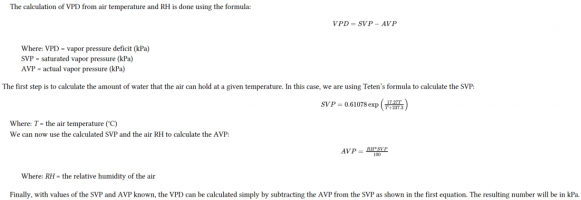I am trying to create a formula to solve for the dependent variable of relative humidity (RH) given the known independent variables of air temperature, leaf surface temperature, and leafVPD.
I recently created three formulas to calculate:
Here are my three formulas and a blank fourth formula I'm trying to create:
(1) Solve for VPD:
exp(34.494-4924.99/(T+237.15))/(T+105)1.57/1000*(1-RH/100)
Where:
(2) Solve for RH of VPD:
100*(1-airVPD/(exp(34.494-4924.99/(T+237.15))/(T+105)1.57/1000))
Where:
(3) Solve for leafVPD:
(exp(34.494-4924.99/(lsT+237.15))/(lsT+105)1.57-RH/100*exp(34.494-4924.99/(T+237.15))/(T+105)1.57)/1000
Where:
(4) Solve for RH of leafVPD:
???
Where:
I recently created three formulas to calculate:
- VPD (vapor pressure deficit)
- RH of VPD
- leafVPD (i.e., VPD accounting for leaf temperature assuming 100% relative humidity inside leaves).
Here are my three formulas and a blank fourth formula I'm trying to create:
(1) Solve for VPD:
exp(34.494-4924.99/(T+237.15))/(T+105)1.57/1000*(1-RH/100)
Where:
- exp = spreadsheet function returning the constant e (Euler's number), approximately equal to 2.71828
- T = air temperature in degrees Celcius; e.g., 25
- RH = relative humidity in percent; e.g., 70
(2) Solve for RH of VPD:
100*(1-airVPD/(exp(34.494-4924.99/(T+237.15))/(T+105)1.57/1000))
Where:
- exp = spreadsheet function returning the constant e (Euler's number), approximately equal to 2.71828
- T = air temperature in degrees Celcius; e.g., 25
- airVPD = target VPD in kPa; e.g., 1.0
(3) Solve for leafVPD:
(exp(34.494-4924.99/(lsT+237.15))/(lsT+105)1.57-RH/100*exp(34.494-4924.99/(T+237.15))/(T+105)1.57)/1000
Where:
- exp = spreadsheet function returning the constant e (Euler's number), approximately equal to 2.71828
- T = air temperature in degrees Celcius; e.g., 25
- lsT = leaf surface temperature in degrees Celcius; e.g., 23
- RH = relative humidity in percent; e.g., 70
(4) Solve for RH of leafVPD:
???
Where:
- exp = spreadsheet function returning the constant e (Euler's number), approximately equal to 2.71828
- T = air temperature in degrees Celcius; e.g., 25
- lsT = leaf surface temperature in degrees Celcius; e.g., 23
- leafVPD = target leafVPD in kPa; e.g., 1.0


